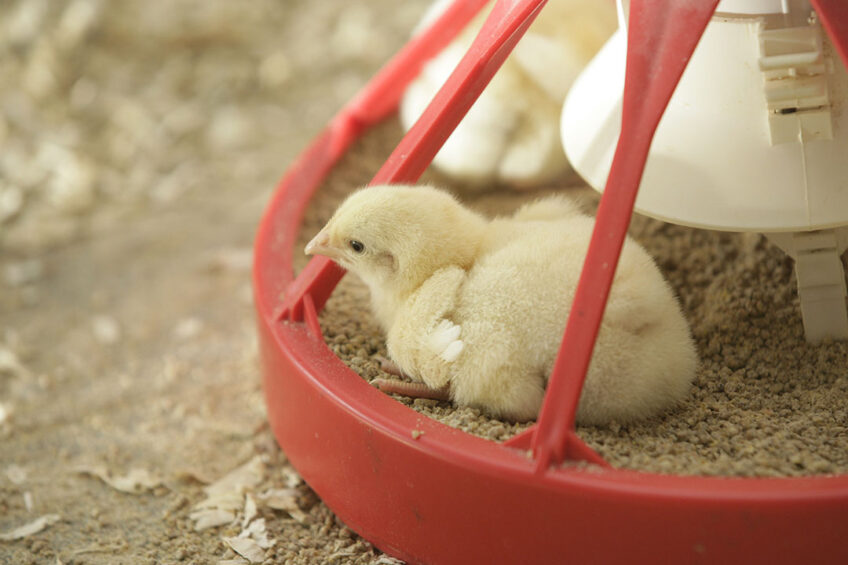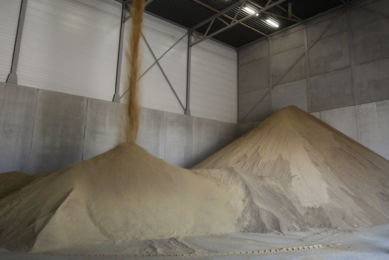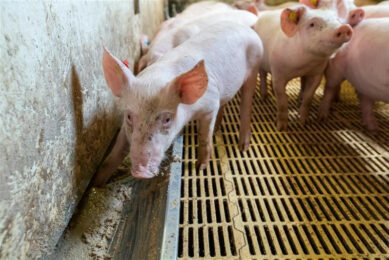Making every broiler chick fit to survive

When preparing broiler feeds, how to ensure total performance and profitability? Key to that is a quick adaptation and a smooth transition after hatch. A carefully balanced and well-designed broiler feeding strategy forms part of that approach. Here is how to do that.
The term “survival of the fittest” was first mentioned by the British biologist Charles Darwin in 1859. The phrase originally applied to explaining evolution and diversity in life, spanning out over a series of generations. Yet the term is also applicable to what is happening within one generation on a broiler farm. After all, when broiler chicks receive a good start, they will be fit and ready to take on challenges for the rest of their lives.
However as logical as that all may sound, the practice is not that easy. When care for young animals is suboptimal, consequences can be plentiful. Think of increased mortality, overgrowth of intestinal microbes, leading to a host with different health problems such as diarrhoea, wet litter, foot pad lesions and extra use of antibiotics – or, if that all does not happen, just lower feed efficiency as well as a reduced animal performance. All in all, it leads to less profit for producers in times of small margins.
That is why paying attention to the youngest animals is worth looking into. Extra attention for young animals will lead to robustness and resilience instead of increased mortality. Similarly, a quick and easy transition without stress for broilers after hatching – after all, stress makes a gut leaky. On top of that: economy matters, as a relatively small investment at a young age will lead to a high return rate at marketing.
A closer look at the digestive system
Before compiling a proper diet for young broiler chicks, it’s important to understand the development of their digestive physiology. After all, adaptation to digest feed takes time, the digestive system needs to develop – this is a process called induction. In addition, the gastro-intestinal tract after hatching is almost sterile and it takes time to establish a good and stable gut microbiome, both in the small intestine, as well as in the caeca.
Time is also an issue when talking about immunity – there is a gap in immunity from innate to adaptive. The first protection in the gut comes through immunoglobulins, from the broiler breeder via the egg yolk. Last but not least, young broiler chicks are very sensitive to protein digestion. When the protein is not digested well, there will be an overgrowth of pathogenic and non-pathogenic microbes in the hind gut. There is always a competition for nutrients going on between the host and the microbes – obviously ideally the host should win that competition, but microbes are required to develop immunity.
Problems that need to be solved
There are several issues that need to be solved to make sure that young broilers make it through their first days after hatching. Young broilers are not able to control their body temperature well; it takes a few days before they manage to do so and become ‘homeothermic’.
- Control of body temperature by regulating the environmental temperature is very important for young broilers.
- The young broilers need quick access to feed and water after hatching.
- The unstable gut microbiome and immature adaptive immune system.
- The next problem could be the result of that again, being the low digestion of high amounts of feed.

When putting all these elements together, 4 main objectives can be discerned what to aim for when the broilers reach one to 2 weeks of age.
1. Establishing a good microbiome quickly
For broilers at 1 to 2 weeks of age, the main objective should be to reach a stable and diverse gut microbiome. To achieve that, the goal should be to reduce the total numbers of all microbes – that includes the pathogenic ones but also the beneficial ones. More specific, that means trying to reduce the numbers of gram-negative bacteria in the small intestine at a young age. That can be achieved by:
- Having a good barrier for microbes with a low pH in the gizzard and proventriculus, i.e. by coarse particles and some fibre;
- Adding non-antibiotic antimicrobials as medium-chain fatty acids (MCFA);
- Creating a high protein digestibility – after all, when there is protein left in the hindgut, then there will be a lot of microbes left in the hindgut, as a consequence a lot of end products due to proteolytic fermentation by these microbes. Their presence can be harmful or even toxic;
- Using non-viscous grains, as these are easy to digest and that is beneficial for the host. If viscous grains would be used, like wheat or barley, these will provide extra substrate for microbes and so increase the numbers of bacteria in the gut;
- Supplying high-density diets which includes a lot of fat, keeping in mind that fat is not a substrate for microbes;
- Staying away from over-feeding, as the young animals’ digestive system is not suited yet to digest a lot of feed.
2. Developing a good immunity
Development of a good immunity should also be a goal to conquer in the first few weeks. After all, at hatch, the animals have innate antibodies (coming mostly from the mother – the maternal antibodies), but these levels decrease whilst specific neonatal antibodies from the adaptive immune system still have to increase. At roughly 2 weeks post-hatching, the level of total amount of antibodies is lowest. The gap between the innate immune system and the acquired immune system therefore needs to be bridged.
The adaptive immune system can be stimulated, through e.g. the addition of specific β-glucans from hydrolysed yeast cell walls as well as proteins, as they are the building stones for the immune system. In addition, microbes can play a role there – indeed, the microbes again. On the one hand they are needed, on the other it’s better not to have too much. When the birds get older, it is good to focus on adding anti-inflammatory substances.
3. Developing a high digestive capacity
The next question is how to develop a high digestive capacity?
- For that, quick access to water and feed, straight after hatch is very important. Therefore, a long transport time between the hatchery and the farm is not ideal.
- In addition, the first feed needs to have a good visual quality to appeal and encourage feed intake. There’s no point in talking about carbohydrates, proteins or fat, if the appearance of the feed is not OK;
- Thirdly, having coarse particles in the feed stimulates the development of the gizzard, which acts as a pacemaker to digest feed gradually in the small intestine;
- The supplementation of high-density diets also matters in the context of high digestibility. That includes diets high in fats, highly digestible proteins, and grains that are non-viscous and do not contain gelatinised starch;
- Caeca are the fermentation vessels of a bird, which also need to develop. That can be done by providing some complex carbohydrates which can be fermented in the caeca, leading to the production of short-chain fatty acids, of which butyrate is the most important.
4. Developing a good walking ability
A good walking ability should be an aim. For that purpose, minerals matter. Calcium and phosphorus are required for mineralisation of bones in a ratio of 2.1 to 1. Yet, virtually all of the calcium goes to the bones, whereas approximately 50% of the digested phosphorus is retained in soft tissues, with the other half being retained in bones. That is why the required optimum ratio between digestible calcium and digestible phosphorus is close to 1 to 1. For a good walking ability, the maximum bone ash mineralisation is not required. High calcium levels in starter diets may sound attractive as calcium is cheap. Yet, the combination of high calcium and low phosphorus is detrimental for bone mineralisation and body weight gain. Lastly, coarse limestone is retained longer in the gizzard, which solubilising slowly eventually will lead to a higher digestibility.
Formulation of feeds for young broilers
Putting all these requirements together, a picture of the ideal feed formulation emerges.
- A good physical quality is essential – that’s why good specifications for particle size are essential, not only after dry but also after wet sieving of mash, crumble or small pellets.
- With regard to carbohydrates, sugars should be avoided. Glucose or dextrose, for instance, are not good ingredients, as the young broilers cannot utilise and metabolise it well, which can even lead to toxicity. Similarly, cooked or viscous grains are not advisable – just raw, coarsely ground corn is a very good grain for those young chicks.
- In terms of protein, the digestibility is very important. Some extra lysine would be good for the development of satellite cells, which will lead to more and better breast meat.
- When talking about fats, the best is to go for high levels, while keeping in mind that the quality of fat is very important. That is why the addition of a lot of oxidative poly-unsaturated oils, that can be found in for instance soybean oil, should be limited, just as poorly digestible saturated fats as C16:0 (palmitic acid) and C18:0 (stearic acid). In short, a mix of soybean oil, rapeseed oil and/or poultry fat is very good for those young broilers.
- When it comes down to minerals, calcium levels should be used at low levels; maybe some extra sodium is required but that would depend on housing and temperature. In closed houses and a moderate climate, extra sodium is not necessary; yet when temperatures are high in combination with open housing, then it is good to have some extra sodium.
- Phytase breaks down phytate and releases phosphorus. In addition, it also breaks down anti-nutritional factors, which can be harmful for young animals. A phytase that is active at a low and wide range of pH would be advisable.
- The addition of medium-chain fatty acids (MCFA) is very important. In addition, it’s possible to consider including organic zinc or 25-OH-vitamin D3 in order to improve immunity and prevent lameness in broilers.
Adaptation and a smooth transition
All in all, to achieve total performance and profitability at marketing, the key message revolves around a quick adaptation and a smooth transition after hatch of broiler chickens, fit to survive. Words which, no doubt, Charles Darwin would have agreed with.
This article is a summary of a presentation held during a webinar on Young Animal Care, held by All About Feed together with the Royal Agrifirm Group, in December 2020. It was organised to launch the company’s new young animal nutrition brand ‘Earlyfeed’. The webinar can still be viewed on demand.
Co-author: Vincent ter beek, editor pig progress






